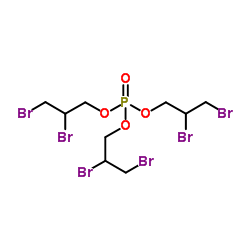Tris(2,3-dibromopropyl) phosphate

Tris(2,3-dibromopropyl) phosphate structure
|
Common Name | Tris(2,3-dibromopropyl) phosphate | ||
|---|---|---|---|---|
| CAS Number | 126-72-7 | Molecular Weight | 697.611 | |
| Density | 2.3±0.1 g/cm3 | Boiling Point | 544.2±50.0 °C at 760 mmHg | |
| Molecular Formula | C9H15Br6O4P | Melting Point | 5ºC | |
| MSDS | Chinese USA | Flash Point | 282.9±30.1 °C | |
| Symbol |



GHS07, GHS08, GHS09 |
Signal Word | Danger | |
|
Haloalkylphosphorus hydrolases purified from Sphingomonas sp. strain TDK1 and Sphingobium sp. strain TCM1.
Appl. Environ. Microbiol. 80(18) , 5866-73, (2014) Phosphotriesterases catalyze the first step of organophosphorus triester degradation. The bacterial phosphotriesterases purified and characterized to date hydrolyze mainly aryl dialkyl phosphates, such as parathion, paraoxon, and chlorpyrifos. In this study, ... |
|
|
Spatial distribution and inter-year variation of hexabromocyclododecane (HBCD) and tris-(2,3-dibromopropyl) isocyanurate (TBC) in farm soils at a peri-urban region.
Chemosphere 90(2) , 182-7, (2013) Hexabromocyclododecane (HBCD) is a high production volume brominated flame retardant (BFR) which has been of increasing environmental and public health concern due to its potential environmental persistency, bioaccumulation and toxicity. Tris-(2,3-dibromoprop... |
|
|
Use of log-linear analysis to construct explanatory models for TDBP- and AFB1-induced mutation spectra in lacI transgenic animals.
Mutat. Res. 425(1) , 55-69, (1999) Mutation spectra recovered from lacI transgenic animals exposed in separate experiments to tris-(2,3-dibromopropyl)phosphate (TDBP) or aflatoxin B1 (AFB1) were examined using log-linear analysis. Log-linear analysis is a categorical procedure that analyses co... |
|
|
Mutagenic response to benzene and tris(2,3-dibromopropyl)-phosphate in the lambda lacI transgenic mouse mutation assay: a standardized approach to in vivo mutation analysis.
Environ. Mol. Mutagen. 28(4) , 342-7, (1996) The genotoxic response of benzene and tris(2,3-dibromopropyl)-phosphate (TDBP) have been evaluated in several tissues using the standardized lambda/lacI (Big Blue) transgenic mouse mutation assay. Separate groups of four to five male B6C3F1 transgenic lambda/... |
|
|
The application of cytogenetics and fluorescence in situ hybridization to fine-needle aspiration in the diagnosis and subclassification of renal neoplasms.
Cancer Cytopathol 118(3) , 137-45, (2010) Percutaneous fine-needle aspiration (FNA) cytology is an important diagnostic test for the evaluation and management of selected renal masses. Cytogenetic analysis of cytology specimens can serve as an adjunct for precise classification because certain tumors... |
|
|
A robust method to quantify low molecular weight contaminants in heparin: detection of tris(2-n-butoxyethyl) phosphate.
Analyst 136(11) , 2330-8, (2011) Recently, oversulfated chondroitin sulfate (OSCS) was identified in contaminated heparin preparations, which were linked to several adverse clinical events and deaths. Orthogonal analytical techniques, namely nuclear magnetic resonance (NMR) and capillary ele... |
|
|
Organophosphate flame retardants and organosiloxanes in predatory freshwater fish from locations across Canada.
Environ. Pollut. 193 , 254-61, (2014) Whole body homogenates of Lake Trout (Salvelinus namaycush) or Walleye (Sander vitreus) collected from Canadian lakes were screened for organophosphate flame retardant (OPFR) and organosiloxane compounds. Six OPFR and five siloxane compounds were detected abo... |
|
|
Tris(2,3-dibromopropyl)phosphate causes a gradient of mutations in the cortex and outer and inner medullas of the kidney of lacI transgenic rats.
Environ. Mol. Mutagen. 36(1) , 1-4, (2000) Tris(2,3-dibromopropyl)phosphate (TDBP) is a kidney carcinogen in rats in which exposure results in tumors specifically in the outer medulla. We have previously shown that TDBP induces mutation in the rat kidney. Here we demonstrate that TDBP induces mutation... |
|
|
Recovery of genomic DNA from a fungus (Sclerotinia homoeocarpa) with high polysaccharide content.
Biotechniques 21(6) , 1030-2, (1996)
|
|
|
Lessons learned from flame retardant use and regulation could enhance future control of potentially hazardous chemicals.
Health Aff. (Millwood.) 30(5) , 906-14, (2011) Flame retardant chemicals, used in many furniture and electronic products to slow combustion, are an example of science and policy problems related to chemical usage. Drawing on a literature review and interviews with stakeholders, we argue that early warning... |